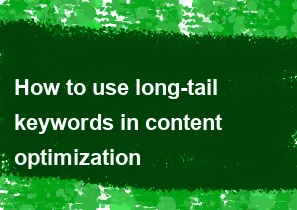How to use long-tail keywords in content optimization

Using long-tail keywords in your content optimization strategy can help improve your search engine rankings and attract more targeted traffic. Long-tail keywords are specific and often longer phrases that users are likely to search for. Here are some steps to effectively use long-tail keywords in your content optimization:
Conduct Keyword Research:
- Use keyword research tools to identify relevant long-tail keywords related to your content or niche.
- Look for keywords that have lower competition but higher search intent.
Understand User Intent:
- Consider the intent behind the long-tail keywords. Are users looking for information, products, services, or answers to specific questions?
Incorporate Keywords Naturally:
- Integrate long-tail keywords naturally into your content. Avoid keyword stuffing, as it can harm the readability and user experience.
- Place keywords in key areas such as the title, headings, meta descriptions, and throughout the content.
Create Quality Content:
- Focus on creating high-quality, valuable content that addresses the user's query or provides relevant information.
- Long-tail keywords should fit seamlessly into your content, enhancing the overall user experience.
Use Long-Tail Keywords in Headings:
- Incorporate long-tail keywords into your heading tags (H1, H2, etc.). This helps search engines understand the structure of your content.
Optimize Meta Descriptions:
- Write compelling meta descriptions that include relevant long-tail keywords. This can improve click-through rates from search engine results.
Create Specific Landing Pages:
- If a particular long-tail keyword represents a distinct topic or product, consider creating a dedicated landing page optimized for that keyword.
Optimize Images and Multimedia:
- Include long-tail keywords in image alt text, file names, and captions to improve the overall SEO of your multimedia content.
Utilize Long-Tail Keywords in URLs:
- If possible, incorporate long-tail keywords into your page URLs. This can contribute to better search engine visibility.
Monitor Performance and Iterate:
- Use analytics tools to track the performance of your content and adjust your strategy based on the data.
- Identify which long-tail keywords are driving traffic and conversions, and refine your approach accordingly.
Remember that the goal is not just to include keywords for the sake of SEO but to provide valuable content that meets the needs of your audience. Balancing keyword optimization with user experience is key to a successful content strategy.
-
Popular Post
- How to optimize for Google's About This Result feature for local businesses
- How to implement multi-language support in an Express.js application
- How to handle and optimize for changes in mobile search behavior
- How to handle CORS in a Node.js application
- How to use Vue.js with a UI framework (e.g., Vuetify, Element UI)
- How to configure Laravel Telescope for monitoring and profiling API requests
- How to create a command-line tool using the Commander.js library in Node.js
- How to implement code splitting in a React.js application
- How to use the AWS SDK for Node.js to interact with various AWS services
- How to use the Node.js Stream API for efficient data processing
- How to implement a cookie parser middleware in Node.js
- How to implement WebSockets for real-time communication in React
-
Latest Post
- How to implement a dynamic form with dynamic field styling based on user input in Next.js
- How to create a custom hook for handling user interactions with the browser's device motion in Next.js
- How to create a custom hook for handling user interactions with the browser's battery status in Next.js
- How to implement a dynamic form with dynamic field visibility based on user input in Next.js
- How to implement a dynamic form with real-time collaboration features in Next.js
- How to create a custom hook for handling user interactions with the browser's media devices in Next.js
- How to use the useSWRInfinite hook for paginating data with a custom loading indicator in Next.js
- How to create a custom hook for handling user interactions with the browser's network status in Next.js
- How to create a custom hook for handling user interactions with the browser's location in Next.js
- How to implement a dynamic form with multi-language support in Next.js
- How to create a custom hook for handling user interactions with the browser's ambient light sensor in Next.js
- How to use the useHover hook for creating interactive image zoom effects in Next.js